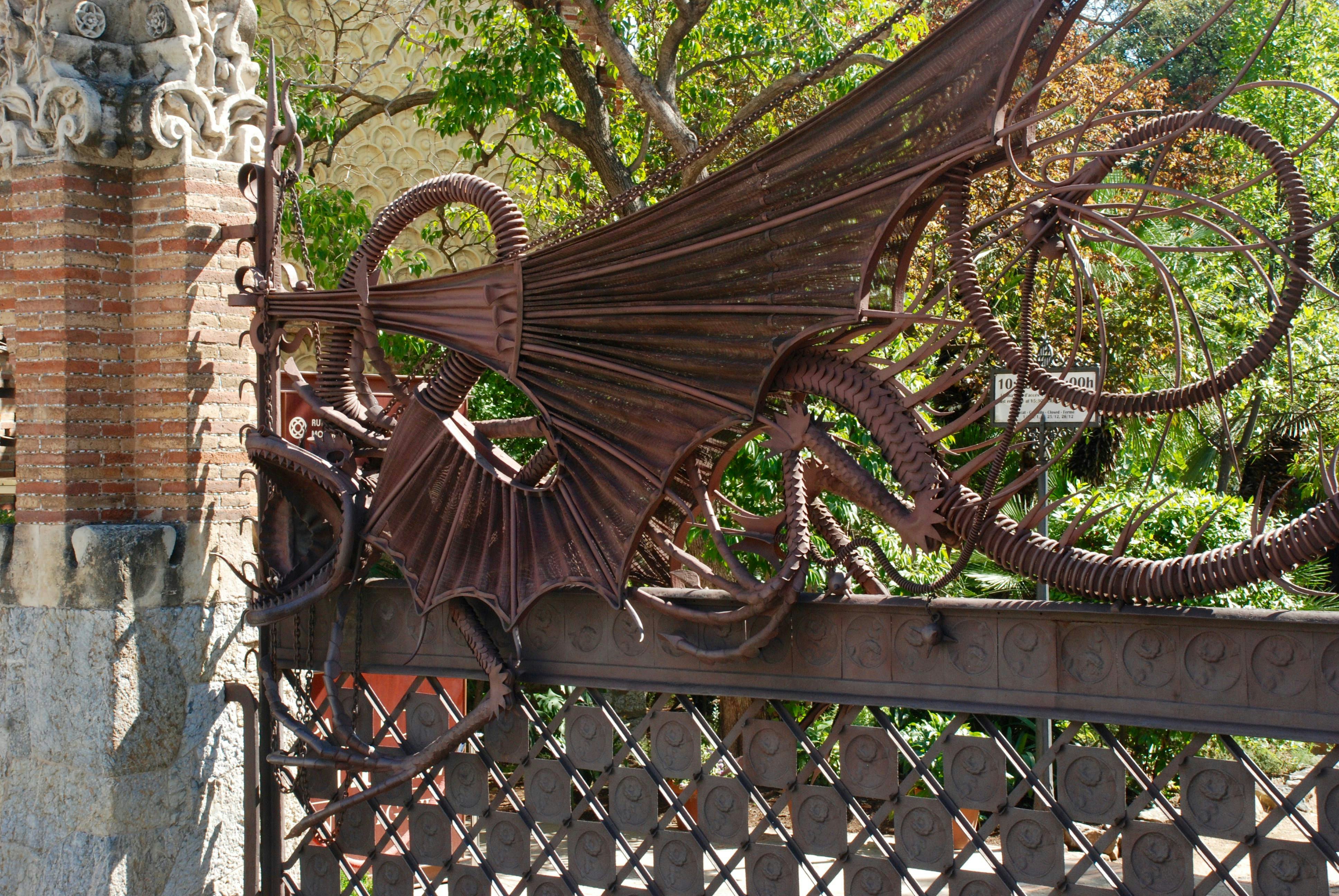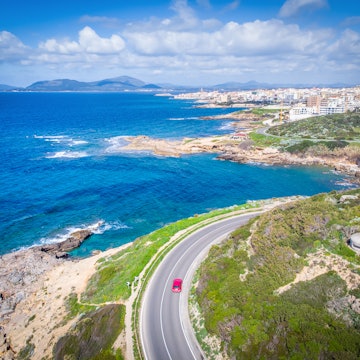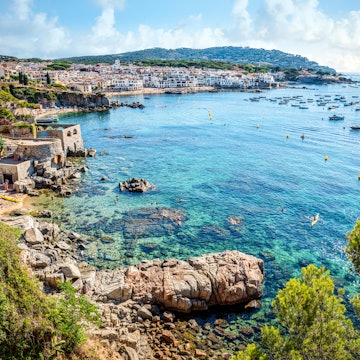

Take your teens to Bunkers del Carmel, a popular spot with Instagrammers looking for the perfect Barcelona panorama. Borut Tridina / Getty Images
Barcelona's popularity as a tourist destination has surged in recent years, but there are still many local barrios (neighbourhoods) to explore away from the crowds. In the centre you’ll be jostling for space amongst tour groups, bicycles and selfie sticks; visit these areas, though, and you might be the only one there.
Explore vast empty parks, visit Gaudí buildings where you won’t have to queue, admire spectacular city views, and get to know areas of the city even many locals don’t know.
Barcelona's best view in El Carmel
The neighbourhood of El Carmel sits just above Gaudí's famous Park Güell. While almost all tourists visit Park Güell, few venture further. El Carmel is characterised by steep narrow streets and leafy residential areas; there aren’t many sights, but the neighbourhood more than makes up for that by offering some incredible city views.
You’ll need to be fit to walk the hilly streets of El Carmel, and even fitter still to climb to the top of Turó de la Rovira to visit the Bunkers del Carmel. Built during the Spanish Civil War, the bunkers were used to house anti-aircraft guns, but later during the 1940s to 1960s became something of a shanty town – at one point housing around 3000 people. Today, locals, students and expats gather here at sunset with picnics and guitars, but if you can wake up early enough, sunrise is even better. It’s from up here that you can enjoy the best view in the whole of Barcelona – a panoramic snapshot of the city that lets you pick out its most iconic landmarks, from the celebrated Sagrada Família to the futuristic Torre Glòries and the verdant Montjuïc hill, all framed by the deep blue of the Mediterranean.
If you’ve got kids, head over to the Parc de la Creueta del Coll, which is home to a large shallow lagoon for swimming and kayaking. Just behind the lagoon, Eduardo Chillida’s Praise of the Water sculpture – like a giant concrete claw – sits suspended in the air.
To get here, take metro line 5 and get out at El Carmel. For the Bunkers, you’ll need to walk a further 1.2km up steep hills. You can also get there on buses 22 and 119.

A Gaudí masterpiece in Sarrià
Sarrià is Barcelona’s upmarket barrio for the well-heeled, filled with luxury apartments, quiet narrow streets, picturesque squares and elegant Catalan architecture. It used to be a separate village until it was swallowed up by the city.

The barrio’s most fascinating sight is one of Gaudí's lesser-known buildings – the Bellesguard tower. Built between 1900 and 1909, it was constructed on the grounds of the residence of Martin the Humane, the last king of the Catalan dynasty, and drew inspiration from his medieval castle home with its turreted towers, stone-covered exterior and portcullis-like doorway. Families should visit Sarrià’s Parc de l’Oreneta, where little ones can enjoy a miniature train ride.
To get here, take the FGC train lines S1, S2 or L6 from Plaça Catalunya or Provença and get out at Sarrià.

A lovely labyrinth in Horta
The quaint, quiet barrio of Horta lies to the north of the centre, and brims with cute plazas and narrow streets. Other than sitting down with the locals to enjoy a nice cold orxata (tiger nut milk) or two in a pretty square, your main reason for coming here will be the Jardins del Laberint d'Horta – a huge green expanse that sits high up among rolling hills. Dating to the late 1700s and early 1800s, it's the oldest garden in Barcelona and is both Neoclassical and Romantic in style. Filled with graceful pavilions, ponds, waterfalls, and busts and statues inspired by Greek and Roman mythology, its highlight is a huge central labyrinth – a proper cypress hedge maze you can really get lost in.
To get to the centre of Horta, take metro line 5 and get out at Horta. For the Parc del Labrint, take metro line 3 and get out at Mundet.

A palace and a monastery in Pedralbes
The Pedralbes barrio is characterised by wide leafy avenues and graceful mansions, backed by the green hills of the Collserola Natural Park. Make a stop at the Pavellons Güell, fronted by Gaudí's exquisite Dragon Gate with its intricate curls of wrought iron.
At the top of Avinguda Pedralbes, you’ll find the Monestir de Pedralbes, hidden behind a stone arch down a narrow cobbled street. Founded in 1327, it features a fresco-covered chapel and arched cloisters surrounding a garden-like courtyard. Further west, along Avinguda Diagonal, you’ll come to the Palau de Pedralbes, painted yellow and covered in rose-coloured stencils; built in the 1900s, it was once the home of the Spanish royal family when they visited Barcelona. The last stop along the avenue is the Parc de Cervantes, filled with over 240 varieties of rose, including the world’s most fragrant – the Mister Lincoln, a hybrid tea rose.
To get here, take metro line 3 and get out at Maria Cristina or Palau Reial.
Cafes and culture in Sant Andreu de Palomar
The village-like barrio of Sant Andreu de Palomar lies to the northeast of Barcelona's centre, and is one of the most charming in the city. Even locals don’t know this barrio unless they live there.
Despite not being well-known, Sant Andreu has some intriguing sights. At the heart sits the Plaza Orfila, and the striking Church of Sant Andreu, one of the most unique in the city. Built on the site of a 10th-century Romanesque church, it’s neo-Gothic in style and has become a symbol of the barrio. Just around the corner, you’ll find Fabra i Coats, a large modern art gallery housed in a former thread and textile factory.
The neighbourhood is filled with quaint squares, lots of independent shops and cafes, and mesmerising Modernista architecture. Stop for a coffee at the historic Versalles bar with its shimmering green facade and undulating wrought-iron balconies, before continuing to the Sant Andreu covered market, one of the most traditional in Barcelona. In the cobbled streets behind the market, you’ll find the Parròquia de Sant Pacià, another lovely neo-Gothic church with ribbed vaults, and original tiles designed by none other than Antoni Gaudí.
To get here, take metro line 1 and get out at Sant Andreu.
Like this? Try these
Get more travel inspiration, tips and exclusive offers sent straight to your inbox with our weekly newsletter. Make sure you're ready for anything with travel insurance from our trusted partners.
Article first published October 2017, and updated July 2019.
















